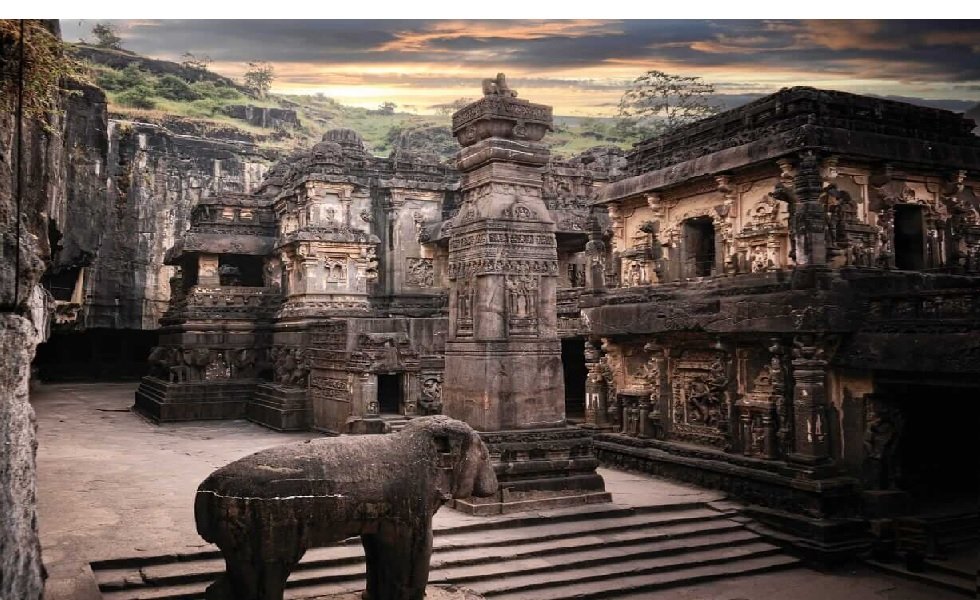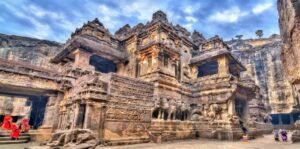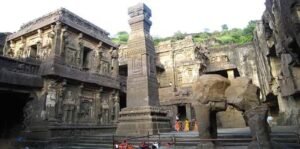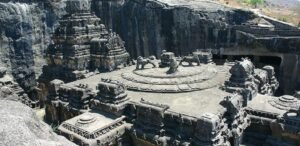
5 Breathtaking Wonders of Ellora Caves – A Majestic Masterpiece!
The Timeless Grandeur of Ellora Caves
Nestled in the rugged landscapes of Maharashtra, India, the Ellora Caves stand as a monumental testament to human creativity, spiritual devotion, and architectural brilliance. Recognized as a UNESCO World Heritage Site, this awe-inspiring complex comprises 34 caves carved painstakingly out of the Charanandri Hills between the 6th and 10th centuries.
What makes Ellora truly extraordinary is its harmonious blend of three major religions—Buddhism, Hinduism, and Jainism—coexisting in a single rock-cut marvel. From colossal temples to intricate sculptures, every cave tells a story of artistic mastery and ancient engineering. In this guide, we unveil the 5 most breathtaking wonders of Ellora Caves that make it a majestic masterpiece of the ancient world.
1.The Kailasa Temple (Cave 16) – A Mountain Turned into a Temple

Why It’s Breathtaking:
“This awe-inspiring monument holds the distinction of being the planet’s most massive single-stone excavation, meticulously chiseled from the mountain’s peak downward in an extraordinary feat of ancient engineering.”
Key Highlights:
- The Grand Scale – Imagine removing 200,000 tons of rock to create a temple—twice the volume of the Parthenon in Greece!
- The Nandi Mandapa – A majestic bull statue (Nandi) facing the sanctum.
- The Dravidian & Nagara Fusion – Towering vimana (spire) and detailed pillars.
- Pro Tip: Visit early morning to see sunlight illuminating the carvings, creating a divine golden glow.
2.The Vishvakarma Cave (Cave 10) – The Buddhist ‘Cathedral’
Why It’s Breathtaking:
- Also called the “Carpenter’s Cave” due to its wood-like finish.
- Features a 15-foot Buddha statue in a preaching pose.
- A stupa with a hidden balcony where monks once chanted.
Key Highlights:
- The Chaitya Hall – A prayer hall with ribbed arches resembling wooden beams.
- The Acoustics – Designed so that whispers at the altar can be heard clearly across the hall!
- Sunlight Magic – The central window allows sunlight to fall directly on the Buddha’s face at noon.
- Fun Fact: This cave is the only Buddhist chaitya at Ellora, making it a rare gem!
3.The Dashavatara Cave (Cave 15) – A Hindu Epic in Stone
Why It’s Breathtaking:
- Dedicated to Lord Vishnu’s 10 incarnations (Dashavatara).
- Features two-story architecture with panels of gods and goddesses.
- The only cave with inscriptions of its builders, the Rashtrakuta dynasty.
Key Highlights:
- Vishnu as Narasimha – A stunning sculpture of the half-lion, half-man avatar.
- Shiva’s Cosmic Dance – A rare depiction of Shiva as Nataraja.
- The Upper Pavilion – Offers a panoramic view of the Kailasa Temple.
Did You Know? This cave was originally a Buddhist monastery before being transformed into a Hindu shrine!
4.The Indra Sabha (Cave 32) – Jainism’s Divine Abode

Why It’s Breathtaking:
- The finest Jain cave at Ellora, dedicated to Lord Mahavira.
- Features a miniature Kailasa-like temple inside.
- Exquisite carvings of lotus flowers, elephants, and celestial dancers.
Key Highlights:
- The Indra Sabha Sculpture – A majestic image of Indra, the king of gods.
- The Lotus Ceiling – A mesmerizing stone lotus hanging from the roof.
- The Tirthankara Statues – Serene figures of Jain saints in deep meditation.
Best Time to Visit: Late afternoon, when soft light enhances the cave’s delicate details.
5.The Rameshvara Cave (Cave 21) – Where Mythology Comes Alive
Why It’s Breathtaking:
- One of the oldest Hindu caves at Ellora.
- Features river goddesses (Ganga & Yamuna) at the entrance.
- Dramatic scenes from Shiva’s marriage to Parvati.
Key Highlights:
- The Dancing Shiva – A dynamic sculpture of Nataraja surrounded by musicians.
- The Guardian Dwarapalas – Fierce doorkeeper statues protecting the sanctum.
- The Hidden Water Channel – An ancient drainage system still functional today!
Hidden Gem: Look for the rare carving of Shiva catching Ganga in his hair—an iconic mythological moment!
6.The Architectural Marvel of Ellora: A UNESCO World Heritage Site
The Ellora Caves stand as an extraordinary testament to ancient India’s architectural brilliance and spiritual harmony. Carved meticulously into the Charanandri hills between the 6th and 10th centuries, the Ellora Caves—a UNESCO World Heritage Site—comprise 34 remarkable rock-cut monuments. What makes the Ellora Caves truly unique is their seamless integration of Buddhist, Hindu, and Jain traditions within a single complex. The caves showcase unparalleled craftsmanship, from the colossal Kailasa Temple to delicate Jain carvings, all created using simple tools and remarkable precision. This archaeological wonder continues to awe visitors with its scale, artistry, and enduring legacy as a symbol of India’s rich cultural heritage, forever immortalizing the Ellora Caves as a masterpiece of human achievement.
7.Planning Your Visit: Essential Tips for Exploring Ellora Caves
To make the most of your Ellora Caves visit, plan to arrive early (by 8 AM) to avoid crowds and enjoy cooler temperatures. Wear sturdy shoes as you’ll navigate uneven rock surfaces and steep staircases across the expansive site. Carry sufficient water, sunscreen, and a hat—shade is limited around the cave complex. Hiring a licensed guide (available at the entrance) will enrich your experience with historical insights. Don’t miss the sound-and-light show in nearby Aurangabad to complete your cultural immersion.
8.The Sacred Trilogy: How Three Religions Coexist at Ellora

The Ellora Caves stand as a rare testament to India’s tradition of religious harmony, where Buddhist, Hindu, and Jain traditions flourished side by side. Carved between the 6th and 10th centuries, the caves progress chronologically from Buddhist monasteries to Hindu temples before culminating in exquisite Jain shrines. Remarkably, this sacred complex shows no evidence of conflict—instead, it reveals how artisans borrowed artistic motifs across faiths. The proximity of a monumental Shiva temple (Kailasa) to serene Buddha statues and intricate Jain Tirthankaras speaks volumes about medieval India’s pluralism. This unique coexistence makes Ellora not just an archaeological wonder, but a timeless symbol of unity in diversity.
9.Engineering Marvels: The Ancient Techniques Behind Ellora’s Creation
The creation of Ellora Caves represents one of history’s most astonishing engineering feats, achieved with nothing more than hammers, chisels, and remarkable precision. Artisans employed a unique “top-down” excavation technique, first carving the cave ceilings before working downward to create temples from single rock formations. The Kailasa Temple alone required removing 200,000 tons of basalt rock, with its architects maintaining perfect proportions without modern measurement tools. Engineers incorporated natural light shafts and hidden drainage systems that still function today, showcasing their advanced understanding of structural integrity. These methods, passed down through generations of craftsmen, transformed solid volcanic cliffs into sacred spaces that have endured for over 1,300 years.
10.Hidden Symbolism: Decoding the Spiritual Art of Ellora’s Sculptures
The sculptures of Ellora Caves whisper ancient spiritual secrets through their intricate symbolism, where every carving holds deeper meaning. Lotus motifs represent enlightenment, while celestial dancers (Apsaras) symbolize the connection between earthly and divine realms. In Cave 16, Shiva’s cosmic dance sculpture encodes the Hindu cycle of creation and destruction through its dynamic posture and surrounding flames. Buddhist caves use empty thrones and footprints to signify Buddha’s presence without direct depiction, honoring early aniconic traditions. Even the cave layouts themselves mirror sacred mandalas, transforming the entire complex into a three-dimensional spiritual diagram guiding pilgrims toward transcendence.
11.Ellora After Dark: The Caves’ Mystical Moonlit Transformation
As twilight descends upon Ellora, the caves undergo an enchanting metamorphosis—moonlight casts dancing shadows across ancient sculptures, bringing the stone deities to life in silent nocturnal worship. The basalt rock formations glow with an ethereal silver sheen, revealing details invisible in daylight’s harsh glare. Night-blooming parijat flowers scent the air near Cave 29, where Shiva’s fierce form seems to emerge from the darkness itself. Special evening tours allow visitors to experience the caves’ spiritual aura amplified by firelight recreating ancient illumination methods. This celestial transformation reminds us why medieval travelers believed these caves became portals to the divine after sunset.
12.Beyond the Main Caves: Lesser-Known Treasures of Ellora
While most visitors flock to Ellora’s famous caves, hidden gems await those who venture off the beaten path. The lesser-visited Cave 14 features stunning reliefs of Durga’s victory over Mahishasura, with details so sharp they seem freshly carved. Nearby, Cave 25’s sunken courtyard contains a rare sculpture of Surya, the sun god, still bearing traces of its original vibrant pigments. The southern Jain caves (30A-33) reveal exquisite ceiling paintings rarely mentioned in guidebooks, their colors protected by centuries of darkness. Even the surrounding hills hide forgotten shrines and meditation cells where monks once sought enlightenment in solitude.
Conclusion: Ellora Caves – A Timeless Journey Through Art & Faith
The Ellora Caves are not just a collection of rock-cut structures—they are a living museum of India’s spiritual and artistic heritage. From the engineering marvel of Kailasa Temple to the serene beauty of Jain caves, every corner tells a story of devotion, skill, and timeless vision.
Final Travel Tips:
“Optimal visiting conditions grace Ellora from late autumn through winter (November-February), when the climate strikes a perfect balance for sightseeing.”
- Must Carry: Water, comfortable shoes, and a camera!
- Guided Tours: Highly recommended to understand the historical depth.
Whether you’re a history buff, spiritual seeker, or art lover, Ellora promises an unforgettable journey into the heart of ancient India. Plan your visit today and witness these 5 breathtaking wonders yourself!
FAQs About Ellora Caves
1. How old are the Ellora Caves?
The caves were carved between the 6th and 10th centuries CE, spanning over 400 years of construction.
2. Why is the Kailasa Temple so special?
It is the world’s largest monolithic structure, carved from a single rock in a top-down excavation—an unparalleled feat of ancient engineering!
3. Are the Ellora Caves Buddhist, Hindu, or Jain?
Ellora uniquely features all three religions:
- Caves 1-12: Buddhist
- Caves 13-29: Hindu
- Caves 30-34: Jain
4. How much time is needed to explore Ellora Caves?
At least 4-5 hours to see the major caves. A full day is ideal for a detailed exploration.
5. Is photography allowed inside the caves?
Yes, but tripods may require special permission. Flash photography is restricted in some areas.
6.When do lighting conditions best showcase the caves’ artistry?”
Early morning (8-11 AM) for cooler temperatures and beautiful lighting on the carvings.
7. Are there entry fees for Ellora Caves?
- Indians: ₹40 per person
- Foreigners: ₹600 per person
- Children (below 15): Free
8. How far is Ellora from Aurangabad?
About 30 km (1-hour drive). You can hire a taxi or take a bus from Aurangabad.
9. Are guides available at Ellora?
Yes, licensed guides are available at the entrance. Audio guides may also be an option.
10. Can I visit Ajanta and Ellora in one day?
Not recommended—they are 100+ km apart (3-hour drive). Dedicate one day each for a proper experience.




